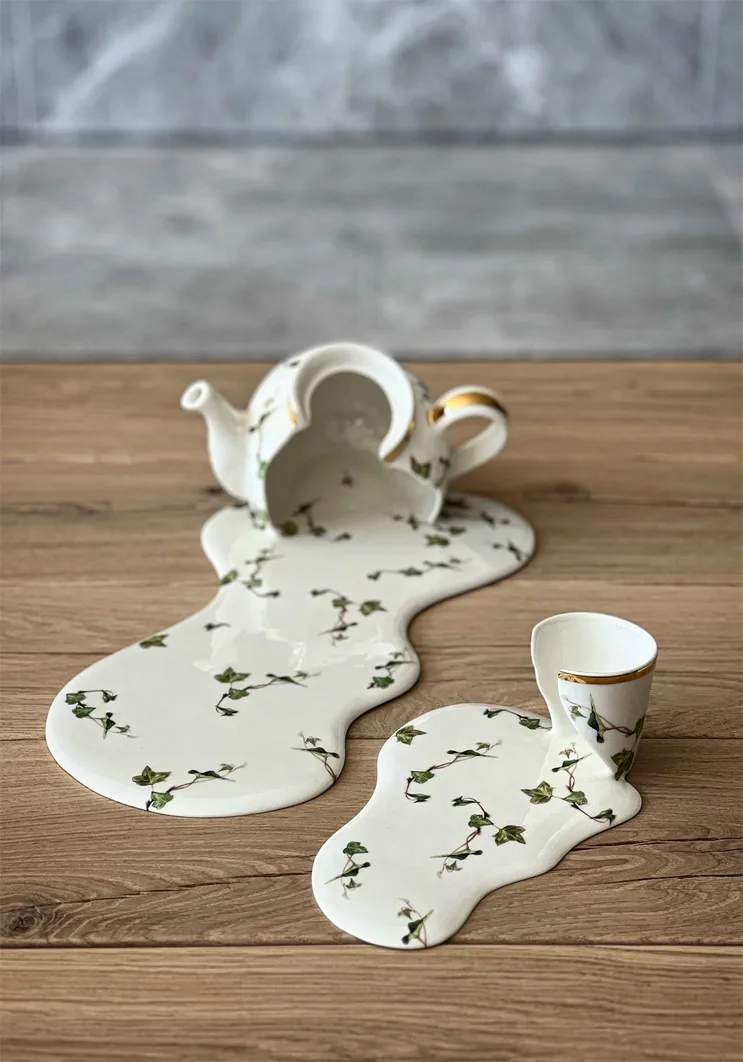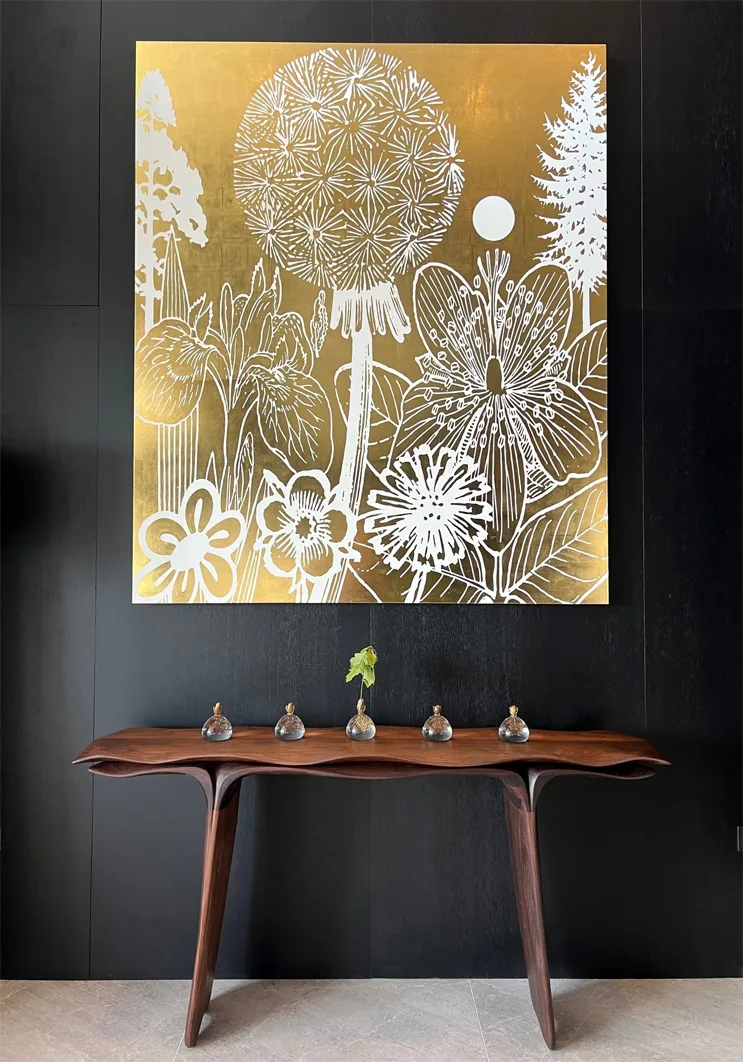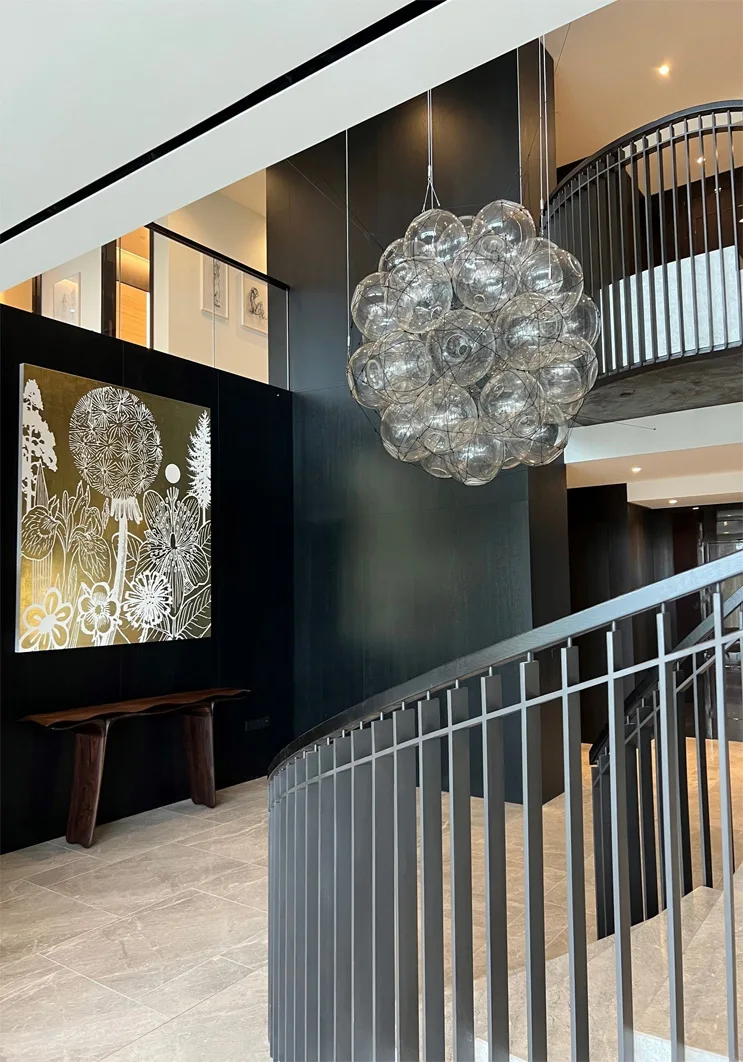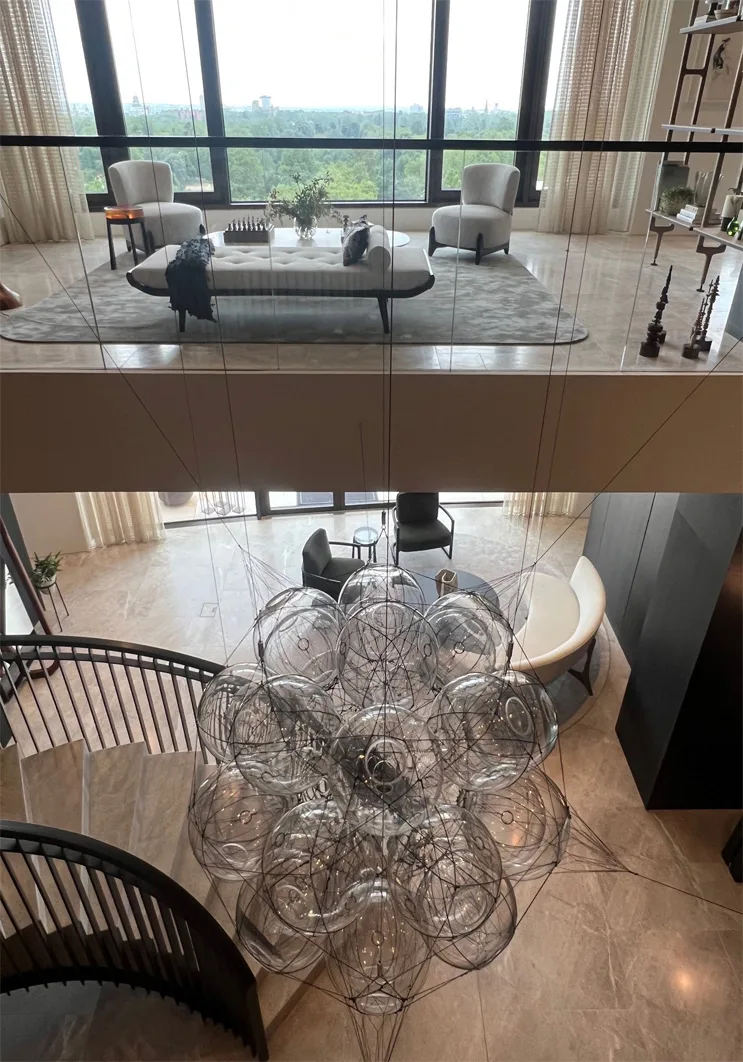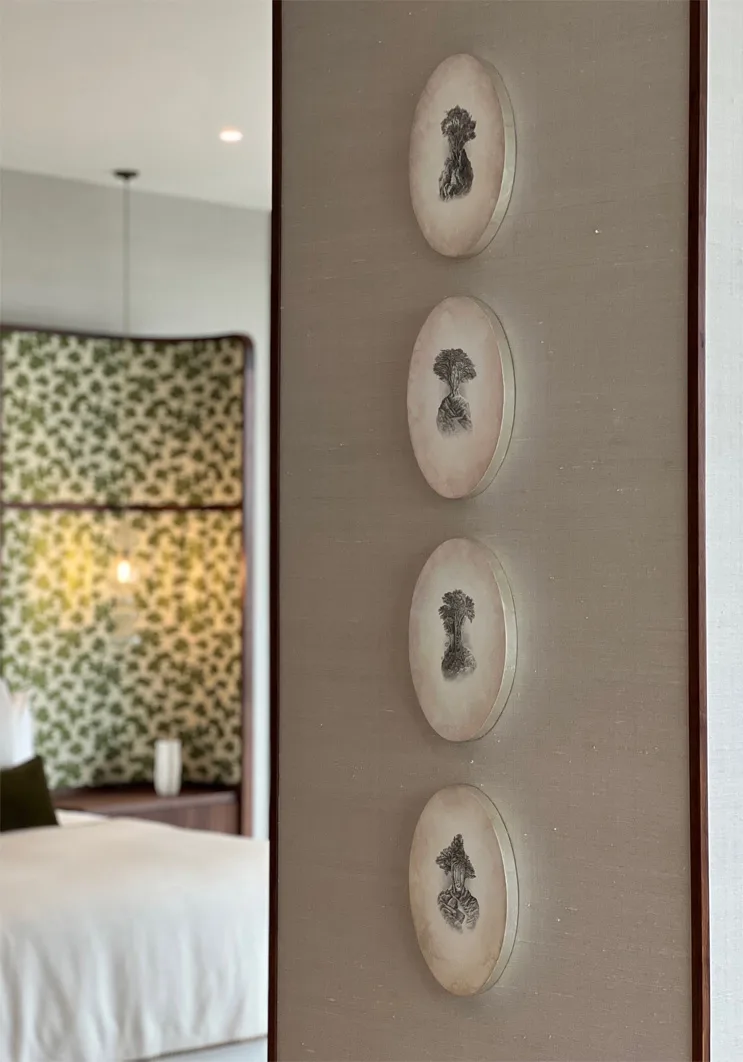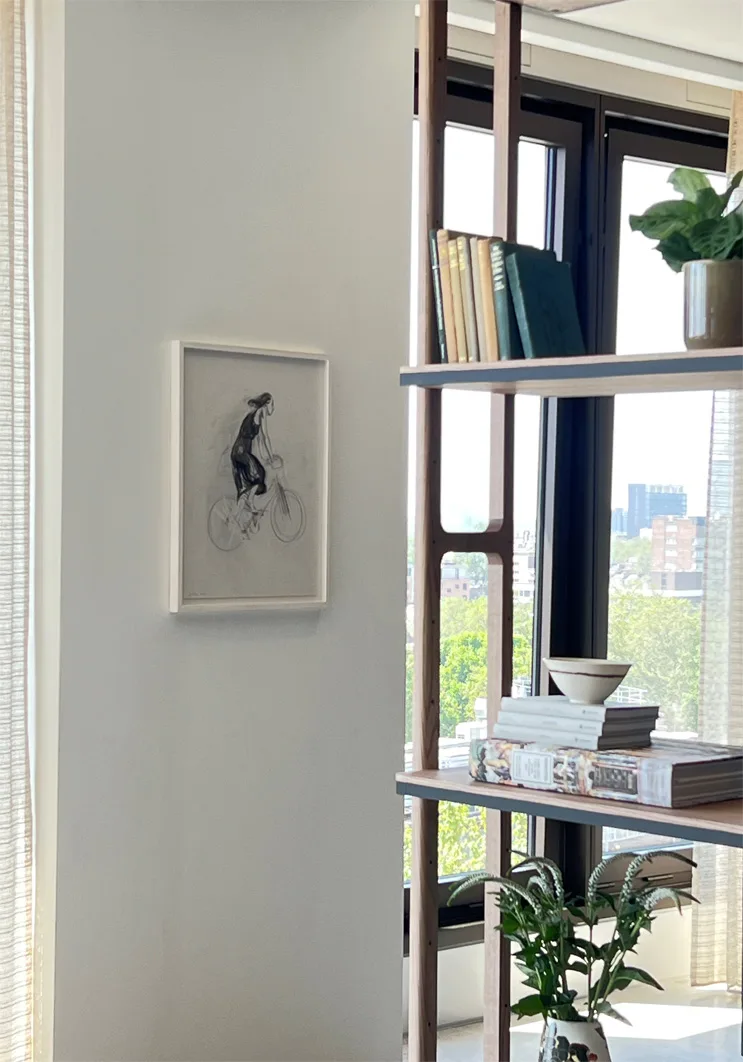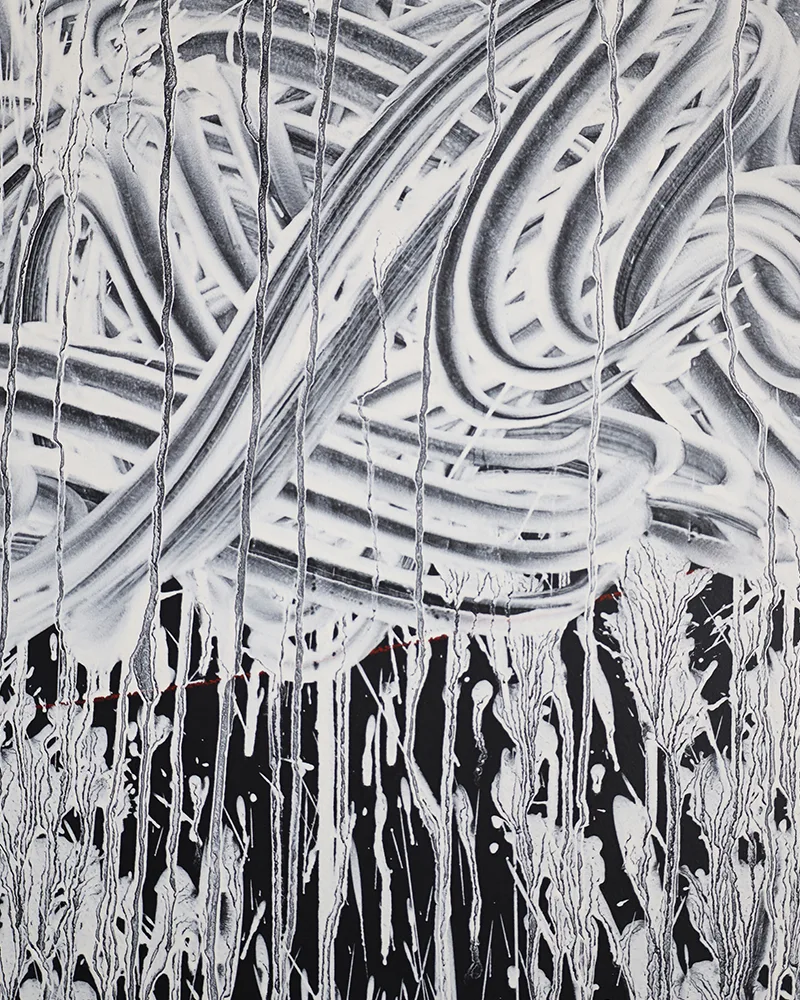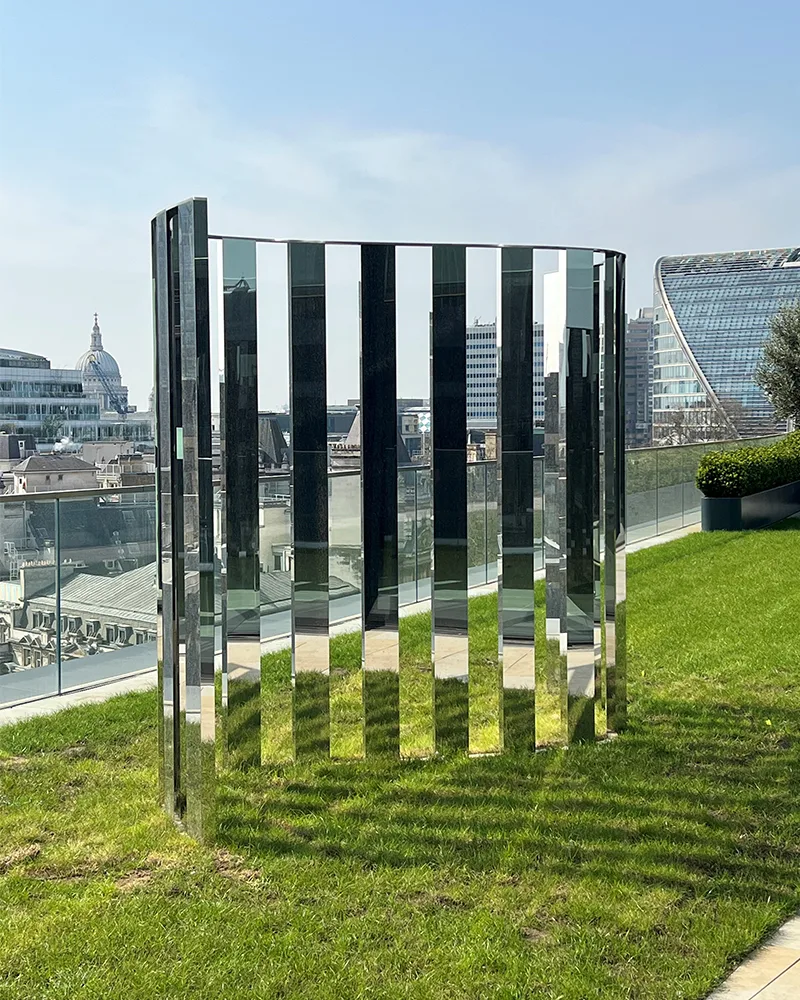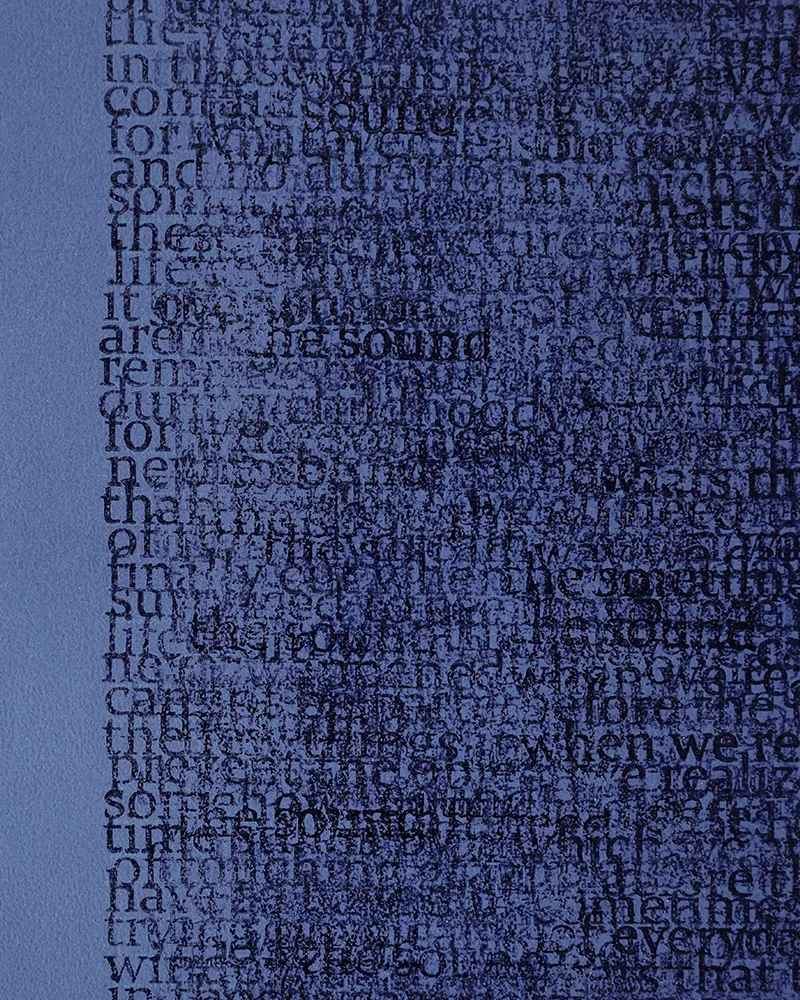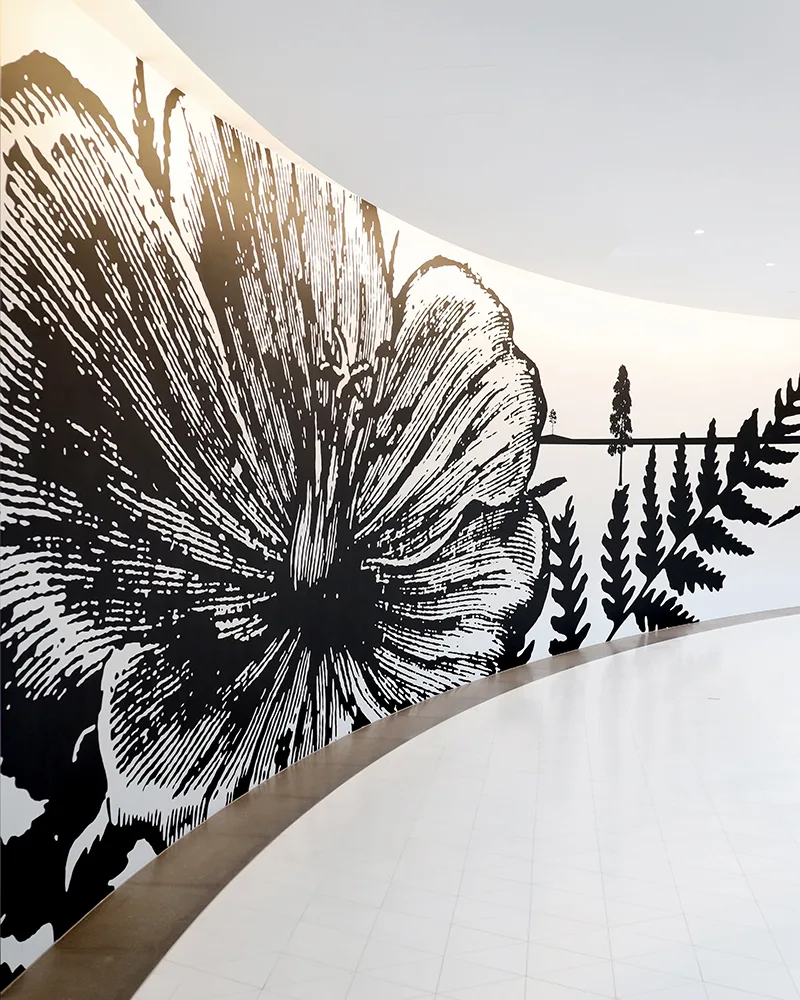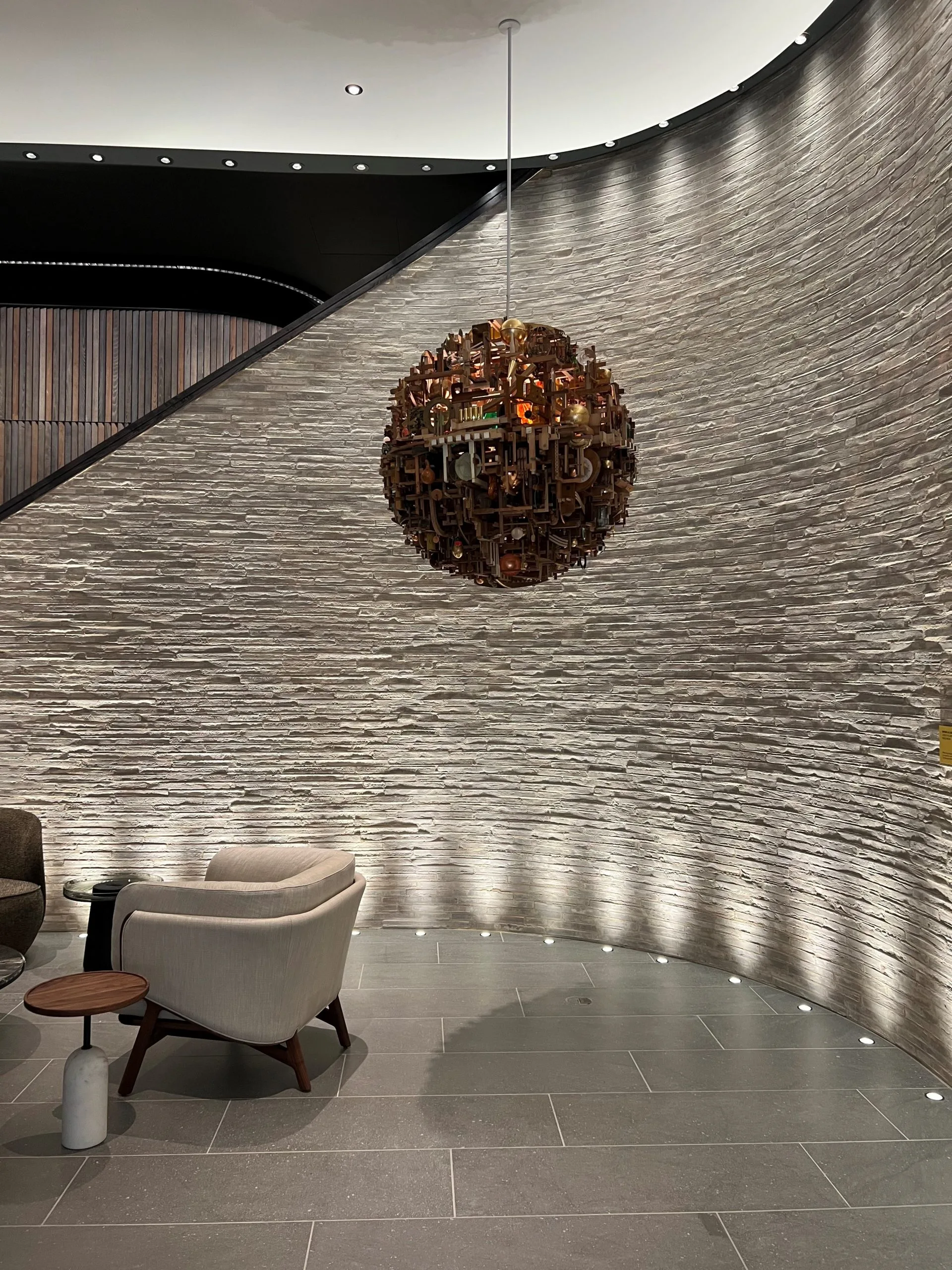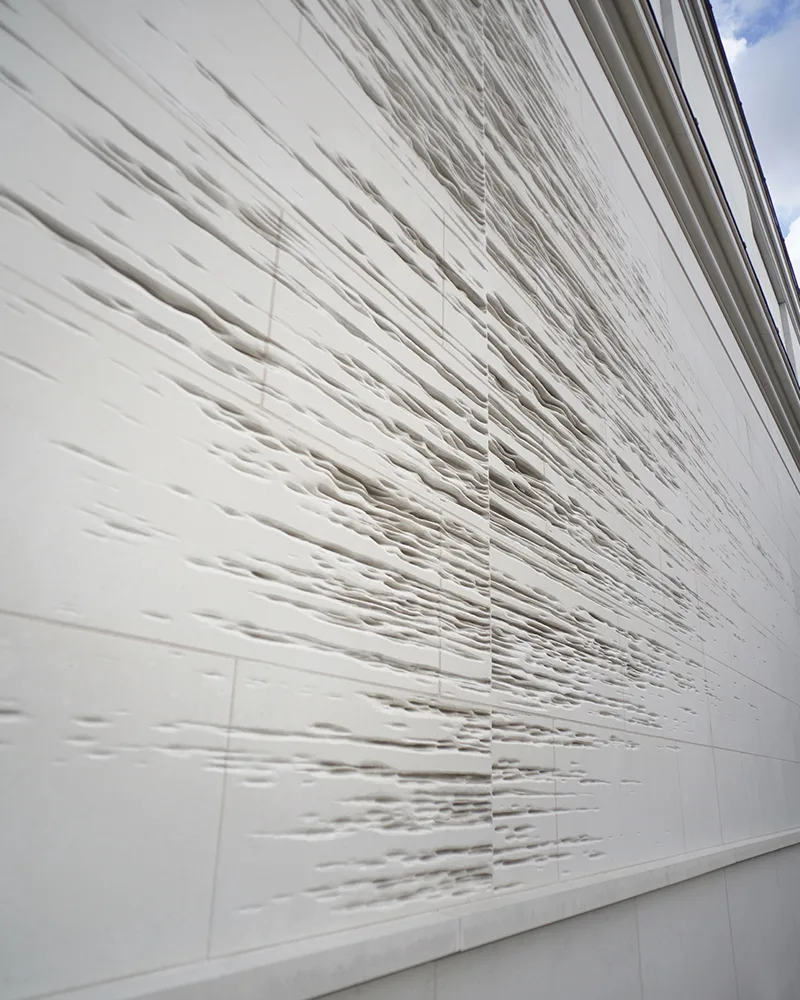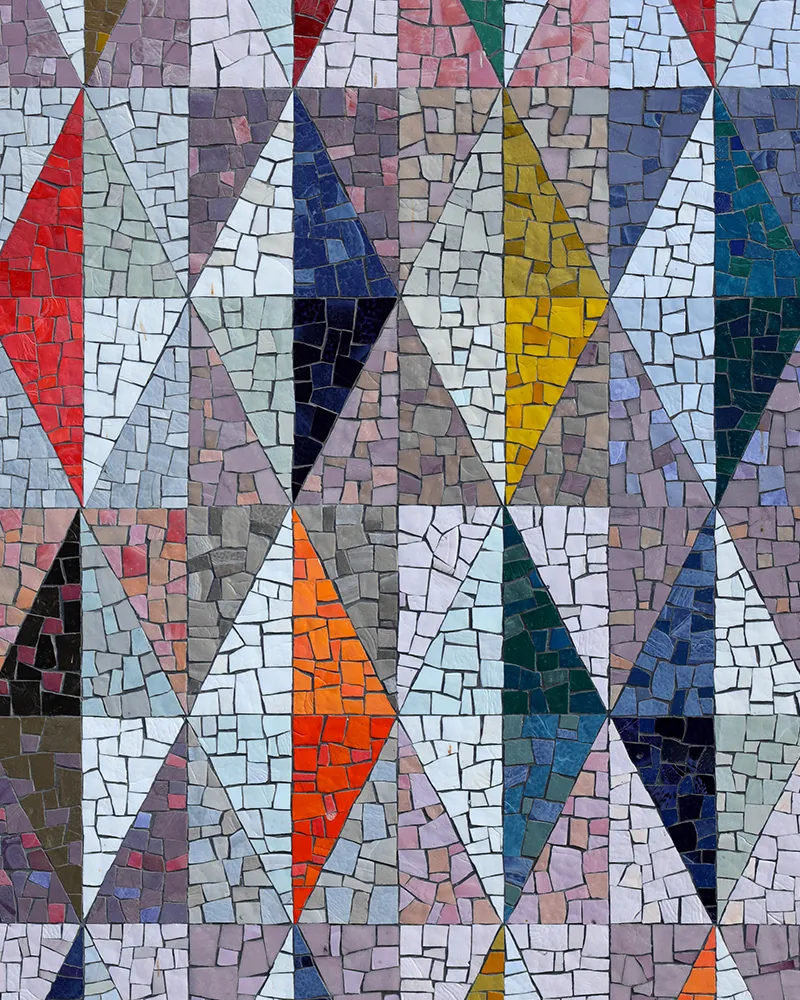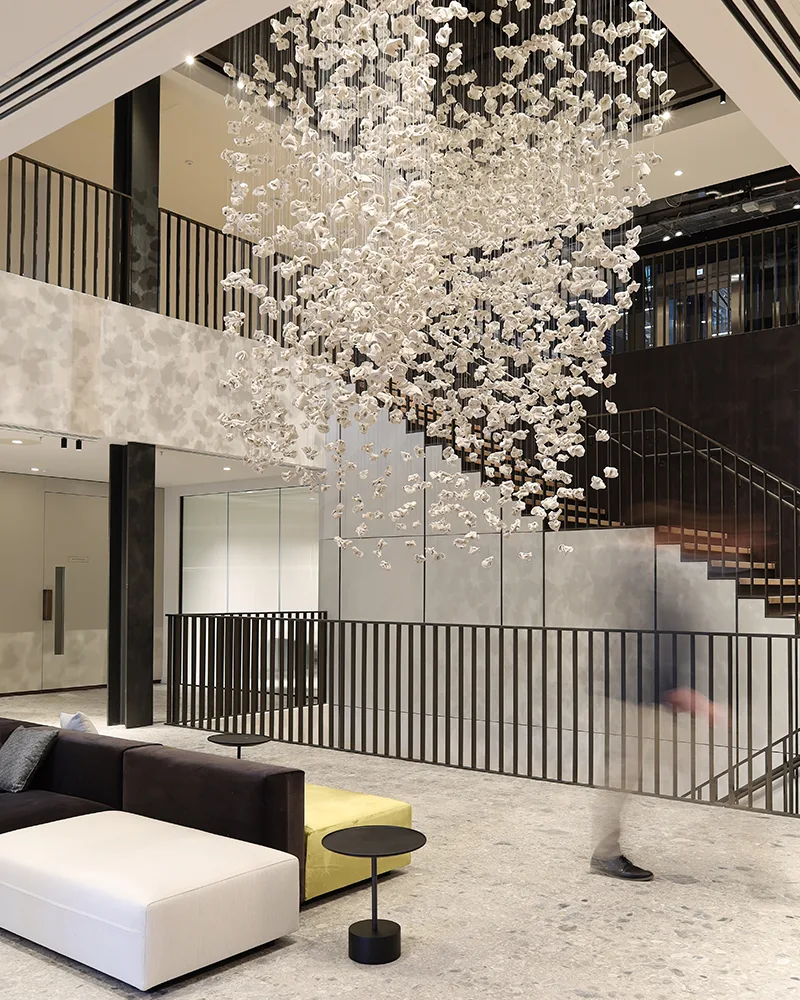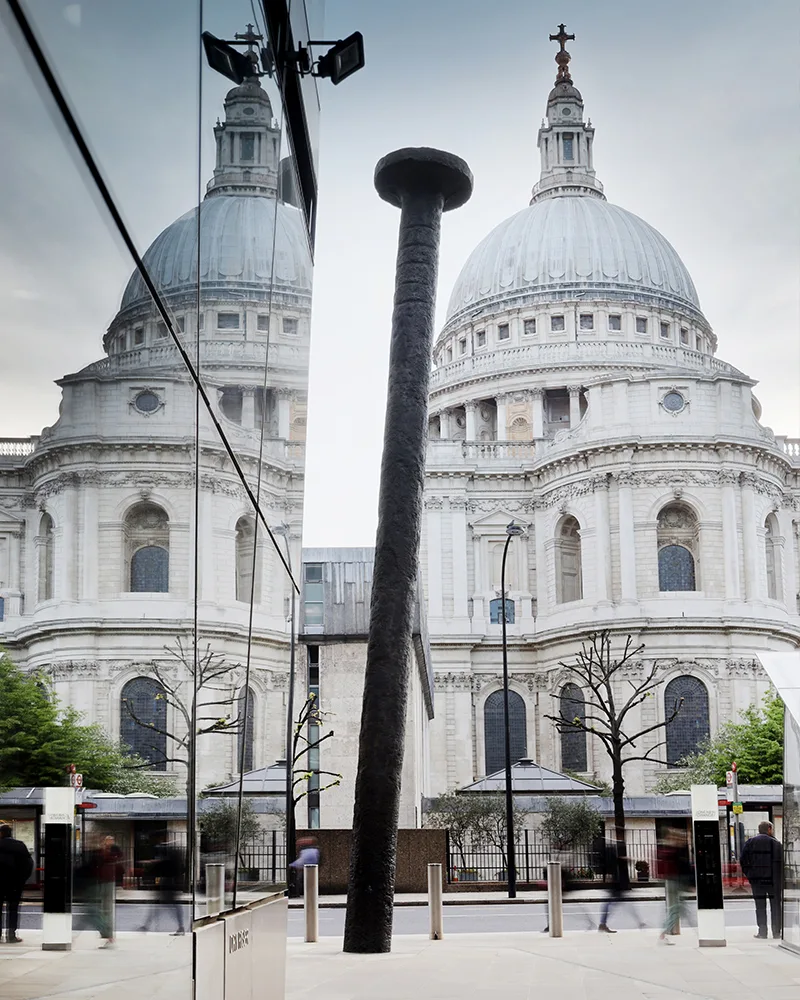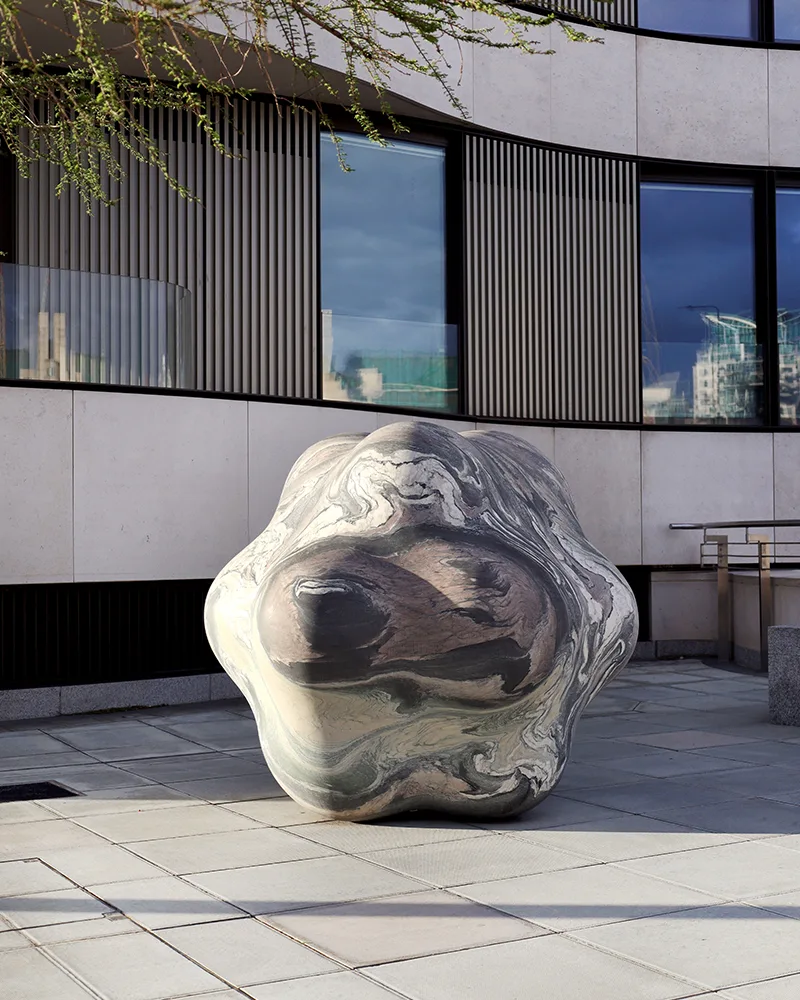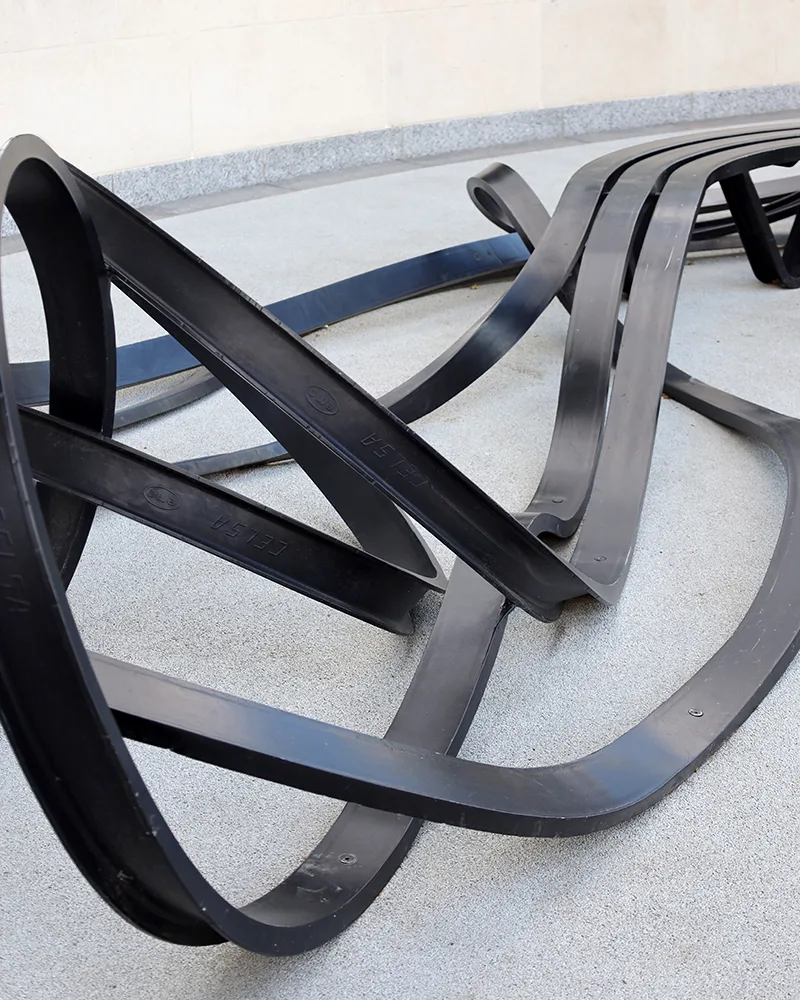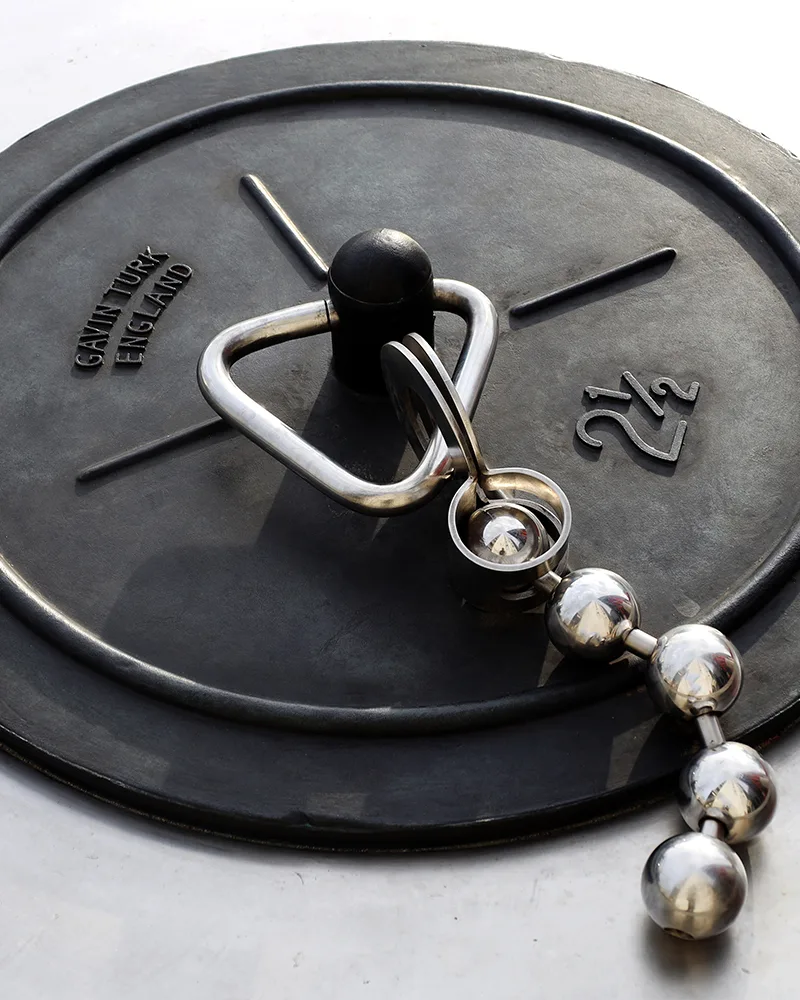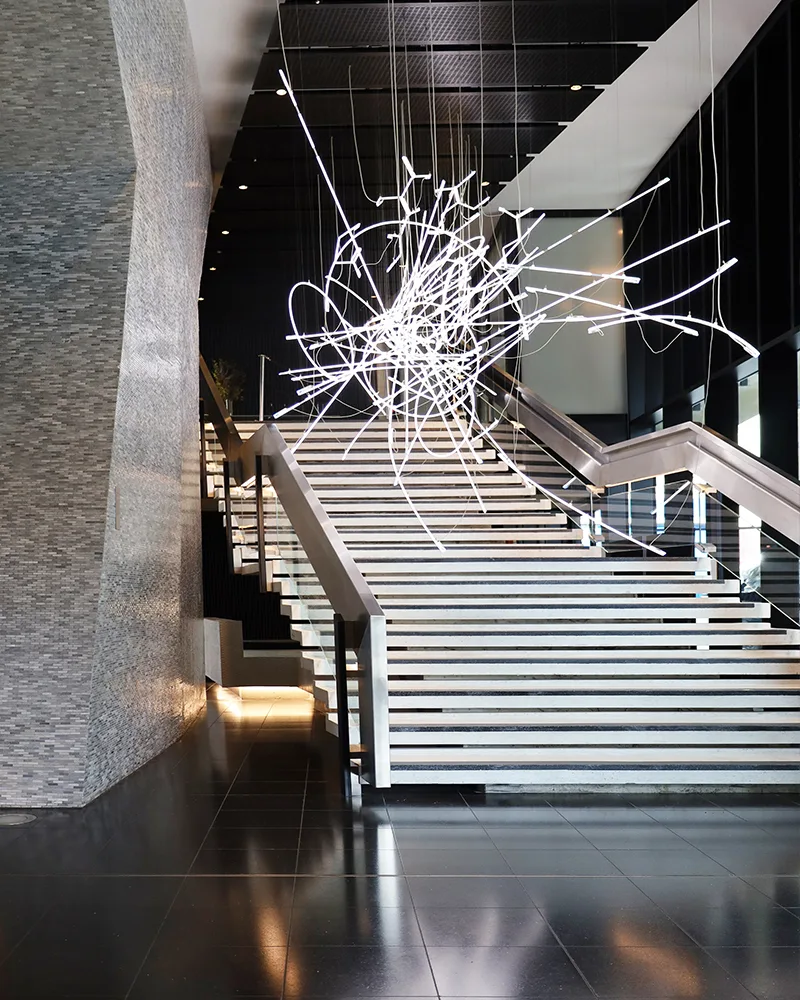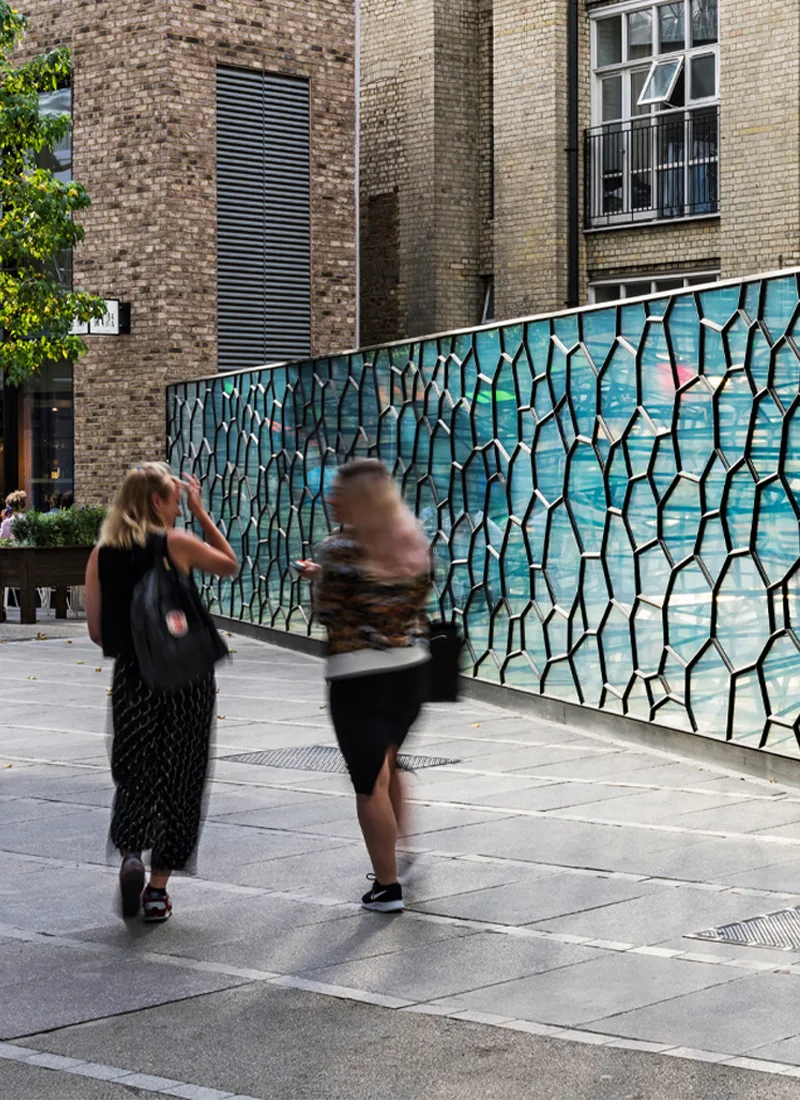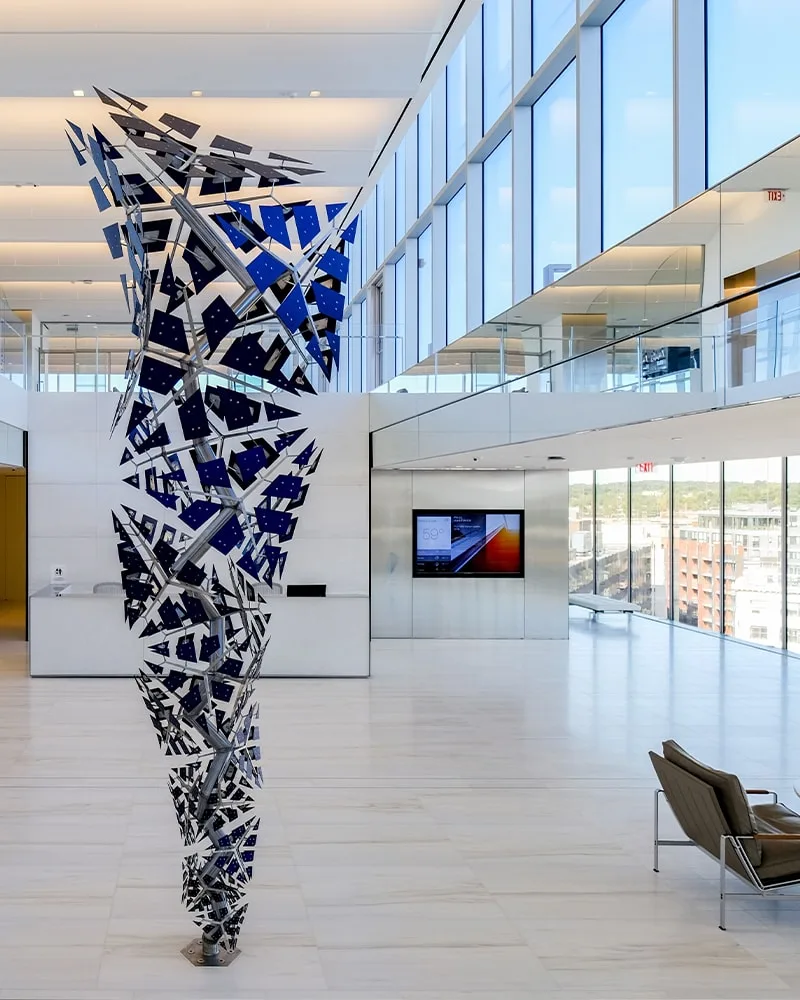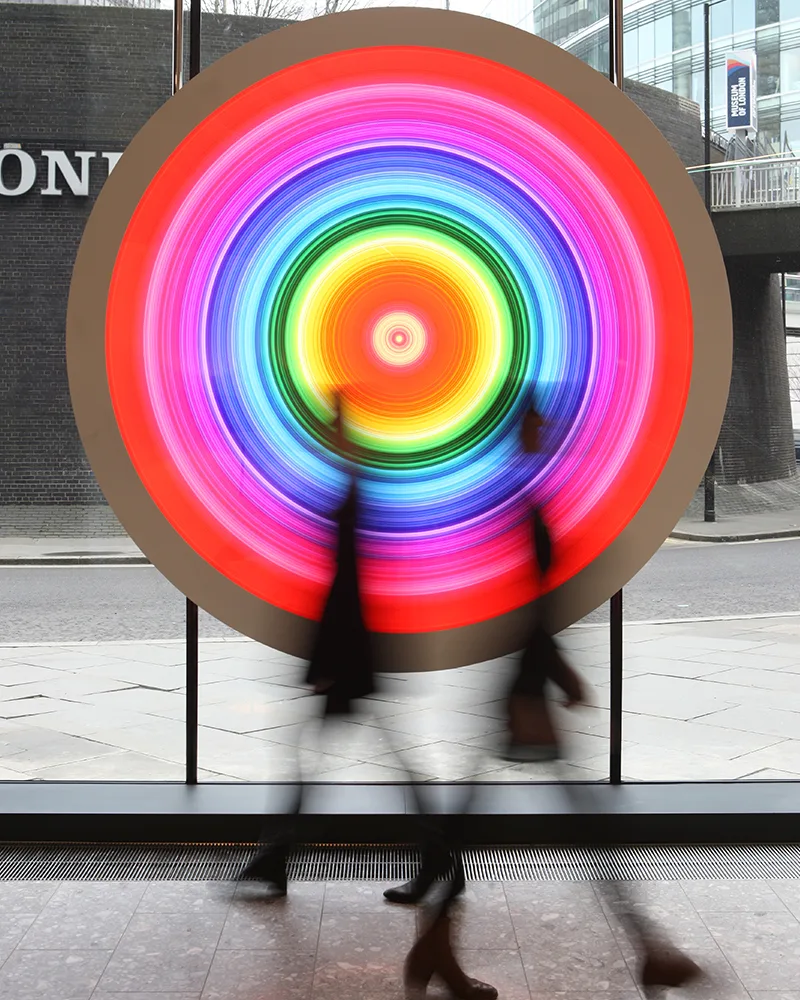
Private Apartment
Various artists
ArtSource teamed up with StudioMorey to curate the artwork for the Townhouse at the Bryanston over looking Hyde Park.
The first artwork you encounter as you enter The Bryanston Townhouse is a suspended artwork by Tomas Saraceno, titled Pneuma, the title referring to the ‘breath’ held within the artwork, the artwork is held in place by weblike netting, in the same room there is an large impressive gold leaf painting by Paul Morrisson, The Park, inspired by Hyde Park and Kensington Gardens.
As you walk through the 13,500 sqft apartment you are greeted by various artworks in every room, from the snake like sculpture by Kate MccGwire made from feathers displayed in a bespoke vitrines, which connects with Andy Harpers painting Xantho, with its organic forms within.
Upstairs in the principle bedroom there are paintings by Sue Arrowsmith and Sue’A Court, as you exit the bedroom on to a mezzanine level looking down on the Tomas Sarceno sculpture, there are five wood turned sculptures by Andy Holden, Auguries, the sculptures are based on the three dimensional sound waves made by five different species of birds, the title refers to the ancient Roman practice of looking at the behaviour of birds to predict the future. On this floor there are also a series of studies by the artist Charles Avery.
More information
Read
Paul Morrison
The Park | 2023
Gold leaf on acrylic
His large-scale work is characterised by monochromatic botanical visions. These boldly rendered gardens and landscapes appear magnified, distorted and cartoon-like and are expressed using a variety of techniques, including painting, drawing, print, sculpture and film. Morrison consciously experiments with scale, taking inspiration from historical engravings, botanical illustrations, comics, animations and found images.
In the artwork, The Park, Paul has drawn inspiration from London parks, especially Hyde Park and Kensington Gardens, the circle that appears in most of Paul’s artworks demonstrates the importance of light to create flora in nature.
Kevin Francis Gray
Head of Oengus | 2023
Statuario marble
In Ancient Irish mythology, Óengus is said to be the god of love, youth and poetic inspiration. Among the many legends surrounding him and his origins, the most famous is that of his love story with Cáer. The vision of Cáer (goddess of dreams and prophecy) comes to Óengus in his sleep and he falls madly in love with her. He searches every kingdom of Ireland – both mortal and godly – in search of her. Finally, he is led to the lake of the Dragon’s Mouth, where Cáer, cursed to take the form of a swan, is chained with 149 other cursed damsels and goddesses. Her captor agrees to release Cáer to Óengus only if he is able to recognise her in swan form. Sensing a trap, Óengus instead transforms himself into a swan and escapes with his beloved, flying away to safety for eternity.
Andy Holden
Auguries | 2023
Turned wood series – Visualisation of
birdsongs (5 birdsongs)
Andy is a Bedfordshire, UK–based artist whose works explore philosophical ideas through video, music, and sculpture. He has exhibited at MOCA Toronto and Tate Britain London; in 2017 he made a touring exhibition with Artangel in collaboration with his father, the ornithologist Peter Holden. His works with birds explore the relationship between mankind and the natural world.
Inspired by some of the bird species seen and heard in Hyde Park , Holden took recordings of their songs and turned the waveforms into sculptures working with an artisan wood turner.
Charles Avery
Various Studies
Charles Avery has dedicated himself to a singular world-building project through the depiction of an imaginary island. Titled The Islanders, this project describes the formation of Avery’s extensive fiction through drawings, writing, objects, architecture, and design.
As part of his practice he is constantly sketching studies that inform the final artworks, we visited Charles in his studio and allowed us to purchase the studies, these will be framed and hung in a salon style installation.
The Island at the center of Avery’s constructed world is located among an archipelago of innumerable constituents. The gateway to the Island is the town of Onomatopoeia, a highly-textured metropolis that bears the hallmarks of an evolving urban landscape. Once the stepping off point for the pioneers who first came, the town experienced rapid transformation from a colonial outpost, to boom town, bustling metropolis, depression-ravaged slum, and finally a regenerated city of culture and tourist destination. The culture and fabric of the Island continue to evolve, further illuminated with each successive work.
The spirit of Avery’s imaginary Island is highly engaged with the disciplines and currency of mathematics, philosophy, economics, and anthropology, and he takes inspiration broadly from literature and comedy. Key elements from his drawings are rendered in physical form in his sculptures and installations. As Avery has said, the Island is “a gymnasium for the imagination and an earnest attempt to align the experience of the viewer with that of the artist.”
Kate MccGwire
Scruze | 2023
Mixed media with Pheasant feathers in a bespoke cabinet
Kate MccGwire (b. 1964) is a British, London-based artist who spent her childhood growing up on the Norfolk Broads. MccGwire’s early memories of this distinct landscape, dominated by its wetlands, serpentine waterways and the wildlife that lives along the region’s waters, form the foundations of her practice, which is inspired by the cycles, patterns and dualities of nature.
Taking feathers as her primary medium, Kate MccGwire goes through labour-intensive processes of collecting, sorting and cleaning her materials to create muscular, writhing forms reminiscent of Classical sculpture and creatures from mythology. These abject structures explore dualities of aesthetics, being simultaneously seductive and repulsive; form, being simultaneously organic and abstract; and movement, appearing fluid yet being static. Through her practice, MccGwire celebrates feathers, which are commonly shed or discarded, as the medium through which she articulates enigmatic anatomies that explore physical and introspective space.
Andy Harper
Xantho | 2023
While this framework may be logically ordered, the marks themselves are organic entities, forming a broad visual library that seems to have taken on its own life, growing and developing through repetition and recombination in each new work. The paintings act almost like a Petri-dish for the culturing of this visual language, and a greenhouse for its cultivation. The forms may seem organic, but on close inspection they are unrelated to anything the natural world has to offer. Rather they are like a man-made form of nature, generated from compulsive repetition and subjective reinterpretations, a world that has somehow grown past the point of offspring to become its own independent entity.
Nika Neelova
Lemniscate
Nika Neelova constructs her striking installations from materials salvaged from the ruins of old buildings. Instead of the more traditional linear way of making, using and disposing of her resources, she favours keeping them as long as possible, recycling and regenerating. Her final pieces speak powerfully on an intuitive level. They contain all the narratives and history of the materials she finds and reflect the functions that were once impressed upon them. Breathing new life into sculptural practice.
These bannister artworks evoke an intimate connection between the human body and the architecture of space. The handrails have the ability to connect through touch as they lead from one place to another. I like the fact they were crafted by human hands over 100 years ago and they stand another century interacting with other hands before they are re-assembled again altering their function and existence. We have a very tactile relationship to them because the banister is originally moulded to fit to the palm of the hand. Their surfaces have collected microscopic bits of skin coating them in DNA of hundreds of people as the physical memory of their existence. They record the way the human body connects to the architecture and the verticality of the space.
The title lemniscate refers to the plane curve with a characteristic shape, consisting of two loops that meet at a central point
Tomas Saraceno
Pneuma | 2023
Hand blown glass, polyester rope, velvet rope
Informed by the worlds of art, architecture, natural sciences and engineering, Tomas Saraceno’s floating sculptures, community projects and interactive installations propose new, sustainable ways of inhabiting and sensing the environment. For more than two decades he has explored the possibility of a future airborne existence as part of his ongoing Air-Port-City / Cloud City project – a utopia of flying metropolises made up of habitable, cell-like platforms that migrate and recombine as freely as clouds themselves. Building on the progressive proposals and theories put forth by R. Buckminster Fuller, Gyula Kosice, Yona Friedman and other visionary architects before him, Saraceno develops engaging proposals and models that invite viewers to conceptualize innovative ways of living and interacting with one another, and with their surroundings at large.
Tomás Saraceno’s work Pneuma channels the interconnections of human and nonhuman beings, living creatures, and non-living matter. His long-term project Aerocene which explores a time when we are free from borders and fossil fuels, one in which humanity collaborates with the atmosphere, taking air both as an element of investigation and as a medium in its own right. Following the logic of the Aerocene, Pneumaexperiments with hand-blown glass to shape a delicate soap bubble, which contains the Pneuma—denoting breath.
Sue Williams A’Court
Escape from Eden series
Graphite and mixed media on panel
Sue’s practice explores the notion of the visual sublime working within painting, collage and drawing, she employs re-imagined landscapes as a trigger for encounter or contemplation.
Classical landscape references are reinterpreted in a new context, rendered in graphite on a variety of surfaces. The form, composition and materiality are meticulously constructed to summon a state of mind rather than a specific location. The tension between the precision drawing and the loosely painted ground references different models of art history and alludes to contrasting types of mental attention competing for the same psychological space.
In her Escape from Eden series the landscapes are from paintings and are made in the shape of the portraits that feature in the artwork such as Mr and Mrs Andrews by Thomas Gainsborough
Livia Marin
Broken Things
Livia Marin is a London-based Chilean artist whose work has been characterized throughout by large-scale installations and the appropriation of mass-produced and mass-consumed objects. Her work was initially informed by the immediate social and political context of Chile in the 1990s that amounted to a transition from a profoundly overt disciplinary regime (given by seventeen years of dictatorship) to an economically disciplinary regime with a strongly developed neo-liberal economic agenda. She employs everyday objects to enquire into the nature of how we relate to material objects in an era dominated by standardization and global circulation. In this, the work seeks to offer a reflection on the relationship we develop with those often unseen objects that meet our daily needs. Central to the work is a trope of estrangement that works to reverse an excess of familiarity that commands the life of the everyday and the dictates of the marketplace. Marin has exhibited widely both in her native Chile and internationally.
The series, Broken Things are made from fragments of everyday objects – cups, bowls, jars, pots and the like – that appear as staged somehow indeterminately between something that is about to collapse or has just been restored; between things that have been invested with the attention of care but that also have the appearance of a ruin. These works aim to reflect on aspects of loss and care, disposal and preservation, and on the relationship we develop with the day-to-day objects that populate our everyday lives.
Sue Arrowsmith
Lighting Up The Dark | 2023
Acrylic & 22.5 carat Champagne Gold Leaf on aluminum panel
Using figurative sources, Sue paintings disclose the linear structure of the landscape through intensely detailed abstract shapes and the more familiar forms of the land. She projects her photographs taken of flora and foliage, and then meticulously records and traces, building a densely interweaving mass of lines that flicker and undulate across the pictorial plane.
‘Sue Arrowsmith’s work has long been rooted in the formal qualities of abstraction and temporality, refracted through the natural world. However, in her new body of work there’s another force at play. Her source material remains photographic – images she has taken of tree forms and leaf clusters, branches of blossom and weeping willows – but now she is allowing the connection between photograph and painted translation to be far freer as she strives to capture the essence of form and not just its outline. These paintings are like haikus to the world she observes on regular walks, whether in London – where she lives and works – or further afield. The tension between abstract form and nature in her work remains taut as a bow string but the work’s presence has been enriched by her growing belief in innate expression and her more experimental approach to materiality.
Increasingly, Arrowsmith has been drawn to paint in metallic ink. She prepares the ink herself creating small pools of liquid gold and bronze by diligently grinding sticks of Japanese sumi ink. Her ongoing experimentation with materiality has allowed her to develop a way to turn solid metal into a malleable and fluid material (rather than relying on the traditional wafer-thin sheets of gold leaf). She brings out its mercurial nature and its earthiness’. (Charlotte Mullins)
Mark Reddy
Stem Spoons | 2022
Native British woods, carved seed pods & found items
The spoon is arguably man’s first vessel, a giver of life, a utensil providing comfort and nourishment: universal and timeless, domestic and intimate. Spoons are the earliest eating tools, dating back as far as the Paleolithic Era. Seashells were connected to small wooden sticks and chips of wood were slowly carved into spoon-like shapes.
Mark Reddy takes the modest, humble form of the spoon and imbues it with symbolic expression.
Skillfully working with wood cut and foraged locally he utilises the innate character inherent in this material, his extraordinary spoons and vessels are carved in the green with simple traditional tools: the hand axe, the maul, the froe and the crook knife, from native Somerset trees.
“I have become increasingly obsessed with the quest for beauty in form through utility of design. The objects that l gravitate towards are those that exemplify the love and understanding of the worked material, the rigour and knowledge of the use of the tools that made them and their purpose. My journey is one of expressing these values through carving green wood.”
Mark Reddy


